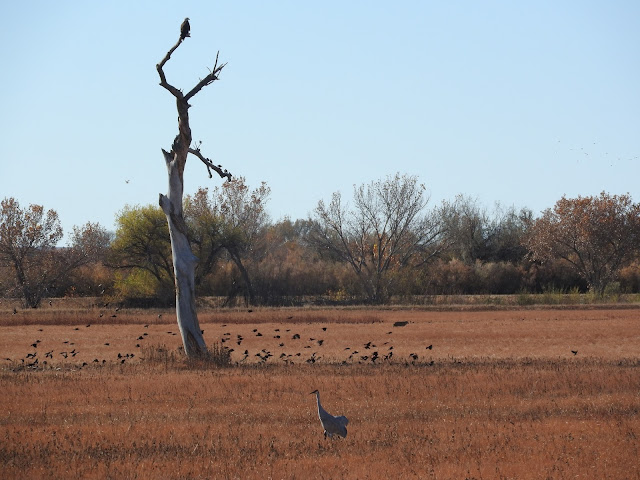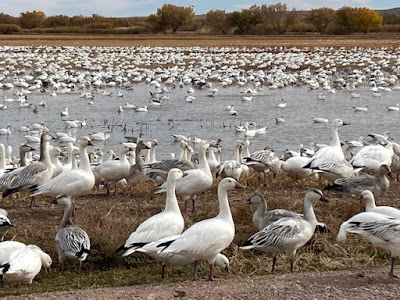Voyager America
A Glorious Fall in the Bosque del Apache, NM
The guiding idea that led to our journey to New Mexico this November was to witness the return of the Sandhill Cranes to winter in the Bosque del Apache National Wildlife Refuge. Each year, starting in November, thousands of Sandhill Cranes return to the Bosque region. Some years ago we saw photos of the Cranes migrating on the North Platte River in Nebraska, and we have dreamed about coming to the Bosque to see these Cranes ever since. The Rio Grande River cuts right through the Bosque and is the life-giving force that creates this vibrant environment that the Cranes return to each winter.
70 million years ago the parting of two massive tectonic plates created the Rio Grande rift valley. The valley runs from north of Albuquerque, NM, to at least Las Cruces, NM, in the south. Once the valley was formed, the Rio Grande river has shaped the valley ever since. It is now a river that has been tamed by irrigation and water management all along its way. However, this jewel of a river, which flows from the mountains in Colorado to Brownsville, TX, emptying into the Gulf, undergirds the history and productivity of its entire length. Karen and I stood by the Rio Grande, called the Rio Bravo del Norte in Mexico, in Big Bend, TX, and now we have roamed the river again in the Rio Grande rift.
 |
| Wildlife refuges and private farmers throughout the Rio Grande Valley plant food, such as corn, and flood fields with water for the migrating birds. |
 |
| Snow Geese and Ross's Geese |
 |
| Sandhill Cranes |
 |
| The Sandhill Cranes that converge on the Rio Grande Valley in the fall migrate from Siberia, Alaska, Canada and the northern Rocky Mountains. |
The combination of being in a rift valley and seeing the fall colors of the grasslands and trees that filled the landscape, led us both to recall the Great Rift Valley in Africa and specifically the grassland and acacia tree landscapes of Uganda, Tanzania, and South Africa. We also were amazed to learn that not only do Sandhill Cranes come here to winter, but so do Snow Geese, including Ross's Geese, and Blackbirds, including Redwing and Brewer's, in large numbers. The interplay of the three types of birds reminded us right away of the wildebeest, zebra, and Thomson's Gazelle migration in the Serengeti in Tanzania. And just like in Africa, such large numbers of birds bring out an array of predators including eagles, hawks, falcons, coyotes, which we saw everyday, and bobcats, that stayed hidden from us. The Bosque del Apache is bursting with life at every turn.
 |
| Arizona Barrel Cactus |
 |
| Thousands of Blackbirds take flight. |
 |
| A Northern Harrier caused these birds to fly up all together. The Northern Harrier is the bigger black bird in the middle. |
 |
| A Bald Eagle sits atop this dead tree while Blackbirds sit on a lower branch and fly around below. A Sandhill Crane walks in front, while a Coyote walks behind. What a tapestry of life! |
 |
| House Finch on Cane Cholla Cactus at sunset. |
Because the Rio Grande cuts through the entire rift valley here, there is bird and wildlife activity throughout the entire valley. It has not been uncommon for us to see Sandhill Cranes, Snow Geese, black birds, and a wide variety of other birds and animals in fields and open areas all along the valley. It is a large, magical ecosystem with the Bosque at its heart.
 |
| Sunset at the Bosque with Sandhill Cranes |













No comments:
Post a Comment